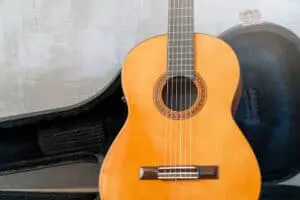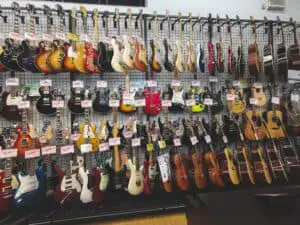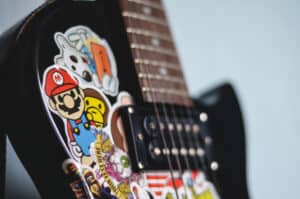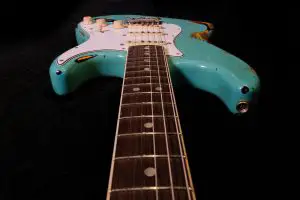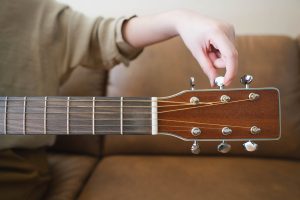
The electric guitar seems harder to play because of all the accessories needed to play it. But it’s only a fancier version of the regular acoustic guitar. Mastering the electric guitar isn’t easy. However, whether you’ve had little experience with the electric guitar or are a total novice, you can be a skilled electric guitarist if you put in the effort required. Who wouldn’t want to plug in an electric guitar to an amazing amp and rock out like Jimi Hendrix?
So how do you begin to learn electric guitar?
Learning the electric guitar involves getting the right guitar and equipment, using appropriate learning resources, and practicing often.
Of course, there are many things you need to know in between. Below is a comprehensive breakdown of the steps you need to follow to be an excellent electric guitarist in no time.
1. Get a Starter Electric Guitar
Electric guitars come in different shapes and sizes. As a result, finding one that’s just right for you can be overwhelming. Before purchasing an electric guitar, you need to ask yourself a few questions. Do you need a full-size guitar or a lightweight one? What’s your budget?
The electric guitar comes in three body styles:
- The solid-body guitar
- The semi-hollow body guitar
- The hollow body
The solid-body guitar is useful when a loud, amplified sound is needed with a lot of effects. It is solid with no hole inside.
On the other hand, the semi-hollow and hollow provide the acoustic sound with high amplification. These guitars have holes, and they’re commonly used to play jazz, rock, blues, and country music.
Additionally, some electric guitar body shapes you should consider include:
V-Shape: this type of guitar has a v-shaped body and is pretty lightweight. It’s commonly used to play classic rock and metal, and the appealing shape makes a statement anywhere you play.
Single cutaway: this type of electric guitar looks like the acoustic guitar. The curve in the guitar body makes it easy to play high notes on the fretboard.
Double cutaway: the double cutaway is a guitar with two body curves near the neck. This guitar shape is the easiest to play and practice on for most people.
Do proper research before buying an electric guitar online and if you’re indecisive, walk into your nearest guitar store, and you’ll get some amazing recommendations. If you don’t have a guitar store nearby, online forums can help you decide.
2. Purchase Electric Guitar Accessories
Having the right guitar gear will ease your learning process. Here are some items you’ll need for your electric guitar.
Guitar Amp
An amp is necessary to enjoy your electric guitar. If you’re a beginner, you don’t need to break the bank to purchase one. However, your amp greatly influences how your guitar will sound, so you need to get one of good quality.
As the name implies, the amp amplifies the sound coming from your guitar. Although you can play the guitar without an amp, you won’t be able to unlock the full potential of your electric guitar without it.
Instrument Cable
An instrument cable is required to connect your electric guitar to your amp. Without it, the amp is useless. I know what’s on your mind, but no, most amps don’t come with cables. You have to buy an instrument cable separately to use the amp. The only exceptions are beginner kits. Beginner guitar kits come with an electric guitar, guitar amp, guitar cable, and other accessories you may need.
Guitar Tuner
A tuner is required to get your guitar in tune. You can order a tuner online or from your local guitar shop. Another convenient option is using an app to get your electric guitar in tune.
Strap
A strap helps you play comfortably while standing up. It also locks your guitar in the proper playing position. Besides, carrying your guitar while playing will start to hurt after a while.
Straps come in different colors, materials, and sizes, so finding one you like shouldn’t be challenging. Leather straps are very comfortable and robust but expensive. Pick a sturdy but lightweight strap so it won’t snap while playing.
Pick
If you’ve never played guitar before, you don’t know what steel strings do to your fingers. Prolonged strumming will make your fingers sore, and it hurts. Although many pro guitarists strum without a pick, it’s best to keep your options open and know what works for you as a beginner.
You should select a thin pick—with a thickness between 0.65 and 0.73. Thin picks help beginners strum with minimum effort.
Capo
Last but not least, a capo will come in handy in your electric guitar journey. Capos are used to clamp a fret so you can play on a different key. It minimizes the stretching you’ll need to play a song.
3. Start With Basic Chords
It would be best to start learning chords first, no matter the song genre you want to play with your electric guitar. Chords are the foundations of your favorite songs, so you need to learn them to play. Additionally, chords help strengthen your fingers and improve your dexterity.
4. Learn How an Amp Works
Learning to use an amp is a core part of playing the electric guitar. Luckily, the amp is very straightforward as its function is to amplify the sound from your guitar.
5. Start Taking Lessons
After you’ve familiarized yourself with the components of your guitar and basic chords, you can start taking lessons. Although you can learn almost everything on your own, a teacher can guide you through the learning process and help you master the instrument quickly. Playing with a fellow electric guitarist will also motivate you to get better.
6. Practice
Make a habit of playing your guitar every day. It’s the only way you can get better. Set a routine and find a quiet environment to practice. As you take lessons and practice often, you’ll start seeing progress in no time.
Listen to legendary electric guitarists to have a good ear and quickly get familiar with chords.
Takeaway
Learning the electric guitar can take months or even years. It’s a slow process, but what matters is learning at your own pace. With the appropriate equipment and daily practice, you’ll be playing a variety of songs sooner than you expect.

